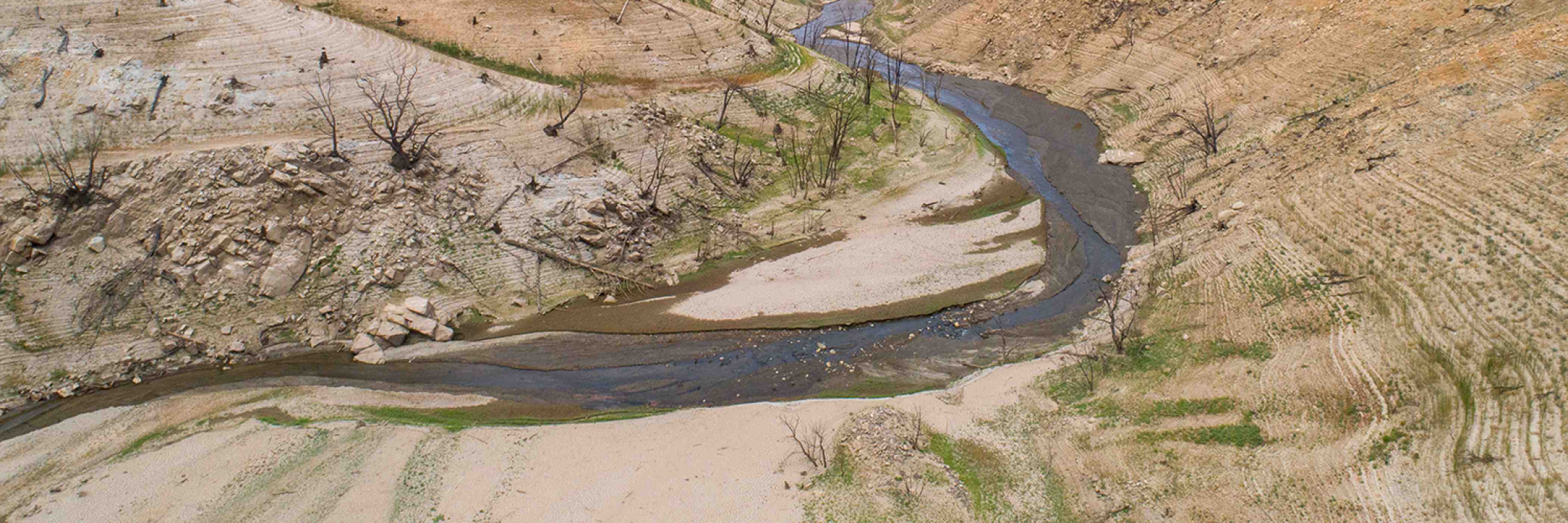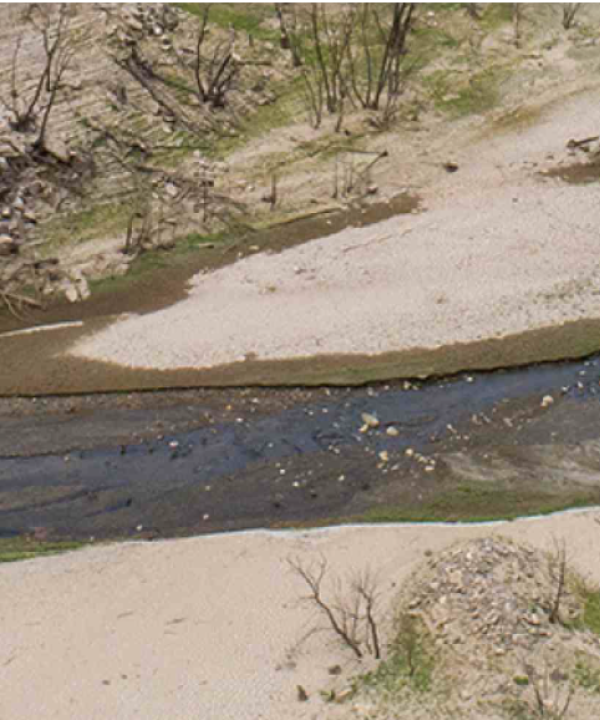October 27, 2021 | Water in the West | News
Despite the rain that drenched central and northern California recently, drought still casts a long shadow over the state. The consequences of a multi-year water shortage are dire: reservoirs that serve millions of people and massive swaths of farmland are disappearing, hydroelectric dams are in danger of losing power and wild salmon are facing mass die outs. Last week, Gov. Gavin Newsom expanded a drought-related state of emergency.
Below, Stanford water experts Newsha Ajami, Rosemary Knight, Felicia Marcus and Barton “Buzz” Thompson discuss lessons learned from previous droughts, imperatives for infrastructure investment and reasons for hope in this arid era.
Ajami, director of urban water policy at Stanford’s Water in the West program, has pioneered novel ways to integrate data science, engineering and policy into water management solutions. Knight is a professor of geophysics in the Stanford School of Earth, Energy & Environmental Sciences (Stanford Earth) who has pioneered the use of geophysical and remote sensing technology to analyze groundwater. Marcus, the William C. Landreth Visiting Fellow at Water in the West, is an attorney and water policy expert who has worked on water-related management and policy issues at the federal, state and local level. Thompson, the Robert E. Paradise Professor in Natural Resources Law, chairs a collaborative effort to help diverse interests in the San Joaquin Valley jointly address drought and long-term water challenges.
What might the average person be surprised to learn about drought and water conservation in California?
Marcus: I think the average person would be surprised at drought’s horrendous impacts on fish and wildlife, the dire impacts on people in rural communities dependent upon shallow wells, and the incredible variation in how much water individual Californians use. Some communities use 5-600 gallons per capita daily, while others use 40-100.
Ajami: In urban areas, more than 50% of water is used for landscaping. About 30% is used to flush toilets. All of this water is drinkable, and we use lots of energy and resources to treat and deliver it to people’s homes.
What lessons learned from the 2012-16 drought can help us be more resilient?
Knight: The 2012-16 drought made us realize how important it is to monitor changes in our groundwater systems on a timescale that allows for adaptive, as close as we can get to real-time, management. An explosion in the availability of satellite data introduces the potential to develop new ways to do this. Our recent study shows the approach’s potential to provide regional water managers with reliable estimates of changing groundwater levels during droughts.
Thompson: We learned the importance of water markets in reducing the cost of droughts. In the last drought, farmer-to-farmer water trades enabled the most productive farmland to get the water needed to produce crops and keep farmhands working.
Is California better prepared for drought than in previous years? If so, how?
Ajami: Knowing how much water is used by various customers is a first step toward improved conservation and efficiency. Fortunately, more homes are metered now, and new multifamily residential buildings are required to have submeters for every unit and all residences are required to have a water meter by 2025. All major water utilities are now required to report their monthly water use and water leakage. This provides a broader understanding of water use and loss across the state and helps achieve better system-level efficiency.
Knight: We now have in place the Sustainable Groundwater Management Act, which requires local water agencies to gather the data needed to better understand the state of groundwater resources in their area and the negative consequences of excessive pumping.
Thompson: We still have a long way to go. Large cities are in generally good shape because they have diversified their water supplies and reduced demand. But many disadvantaged, rural communities are still dependent on shallow wells that can go dry in droughts. Farmers are confronting dramatically reduced surface supplies at the same time the state is telling them to reduce groundwater use. And we still fail to take timely and adequate steps to protect the environment from droughts.
California might start mandatory water restrictions. How successful has that been in the past? How can policymakers improve the likelihood of compliance?
Ajami: Our research shows that during the state’s most recent severe drought, which ended in 2016, many Californians complied with both voluntary and mandatory water restrictions. We saw up to 20% water use reduction during the voluntary phase and another 20-30% during the mandatory restrictions. We have also found that in a majority of cases, water use was permanently reduced, possibly due to structural changes, such as replacing fixtures, appliances or landscaping. However, it is still paramount to focus on reducing per capita water use and save as much water as we can, in case the drought conditions continues for multiple years. The rainstorm that we experienced during the past few days, while a welcomed event, on its’s own is not going to alleviate the water deficit our state is in, accumulated over two severely hot and dry years.
Marcus: Messaging is key. Once you learn how much water is wasted on keeping a lawn an artificial shade of green in the dead of summer, especially in a drought, most of us remember. Additionally, water agencies, particularly in Southern California, put out over half a billion dollars in rebates to change out lawns to drought-tolerant landscaping, to which the public responded extremely well. The mandatory measures worked exceptionally well, in part because we implemented them through sharing information. For example, today it is important for folks to know that one rainstorm does not end a drought of historic proportions and we need to save every drop in case we are in a multi-year drought.
What investments will enable the state to tackle drought and create more sustainable water supplies?
Knight: We need to get more water from the surface down to replenish groundwater systems. To do this, we need to invest in research to assess potential locations. One example of this is a Stanford-led project to integrate geophysical imaging of the subsurface, which allows us to map out the “fast paths” of sand and gravel that can move the water from the ground surface, with geochemical modeling to predict water quality. Recently signed Senate Bill 170 allocates $60 million for floodplain restoration projects, including a portion to support this type of geophysical imaging.
Thompson: If I had to choose three areas for investment, they would be groundwater storage projects, wastewater recycling and stormwater capture. Together, these would allow us to stretch, diversify and expand our water supply.
Ajami: To face modern water challenges, including climate change, aging infrastructure and environmental degradation, we need to invest in soft infrastructure – data, information technology and governance systems - that can enable innovative, multi-benefit and decentralized infrastructure, such as green infrastructure and onsite, small-scale reuse.
What can be done to help rural, disadvantaged communities especially vulnerable to drought due to their reliance on groundwater?
Marcus: Get small systems consolidated into a scale where they can have the managerial, technical and financial capacity to treat water to modern drinking standards. Additionally, the state needs to reject groundwater sustainability plans that involve big agricultural users over-pumping domestic and small system wells. Instead, groundwater sustainability agencies can use a suite of tools, such as helping communities hook up to larger systems, recharging in basins near shallow wells, and drilling deeper wells for small systems and domestic well-owners.
Ajami: Climate change has altered our water cycle: timing and intensity. These impacts are mostly affecting the most vulnerable among us. As we are working on achieving water equity and access to clean water for all, it is important to remember a few things. Establishing water financing strategies that can help small water systems that lack technical, financial and human capacity. These strategies should not only focus on upfront capital cost but also long-term operation and maintenance of systems. We need to invest in portfolio of 21st century water solutions – distributed, decentralized and nature-based – rather than a 20th Century model of once-through gray centralized systems. We also need to value local and indigenous knowledge as part of the solution making process and put in place measures for system level source protection at every scale.
Thompson: These communities suffer from both shallow wells, which can dry up in droughts, and groundwater contamination from local agriculture. The most valuable thing we can do is to connect them with larger nearby water utilities that can supply them with adequate supplies of high-quality drinking water.
What role can nature-based solutions play in supporting water resilience?
Marcus: The beauty of nature-based solutions is that they are more resilient in the face of climate change than gray infrastructure in many cases. So, for example, rather than building floodwalls and levees that can cause destruction and mayhem when breached, we can let the water dissipate and spread out into flood plains, recharging groundwater while providing ecological benefits and green space. Another example is restoring mountain meadows to retain more water and slowly release it over time to make up for the loss of snowpack we will experience with temperature rise. In urban California, projects like the LA County Clean, Safe Water Program will yield $300 million a year in multi-benefit greening projects to capture stormwater for recharge, water quality treatment and much-needed urban greening.
Thompson: These communities suffer from both shallow wells (which can dry up in droughts) and groundwater contamination (from local agriculture). The most valuable thing we can do is to connect them with larger nearby water utilities that can supply them with adequate supplies of high-quality drinking water.
Ajami also served as a gubernatorial appointee to the Bay Area Regional Water Quality Control Board and is currently vice president of the San Francisco Public Utilities Commission. Knight is also the George L. Harrington Professor in Stanford’s School of Earth, Energy & Environmental Sciences and senior fellow with the Stanford Woods Institute for the Environment. Marcus also serves as an Obama Administration appointee to the Commission on Environmental Cooperation–Joint Public Advisory Council, is a founding member of the Water Policy Group and served as chair of the California State Water Resources Control Board. Thompson is also the founding Perry L. McCarty Director and senior fellow of the Stanford Woods Institute for the Environment and faculty director of Stanford’s Water in the West program.



![[Woods Logo]](/sites/default/files/logos/footer-logo-woods.png)
![[Bill Lane Center Logo]](/sites/default/files/logos/footer-logo-billlane.png)